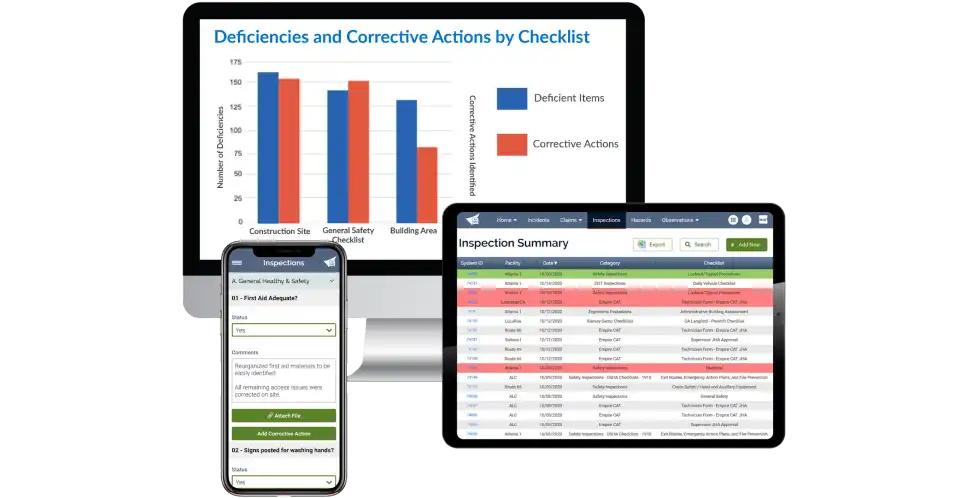June 18, 2024 7 min read

Complete Guide to DMADV Six Sigma
Industry:
Solution:

When manufacturers seek to innovate and optimize their processes, products, or services, they often turn to the structured methodology known as DMADV Six Sigma. In this blog, we’ll examine DMADV and explore its benefits for your organization, including how it differs from DMAIC, and provide tips for training your workforce in lean manufacturing and Six Sigma best practices.
What is DMADV?
DMADV is a methodology within Six Sigma that focuses on designing new processes, products, or services. It stands for Define, Measure, Analyze, Design, and Verify. This approach is used when existing processes are not adequate and need to be completely re-engineered to meet customer requirements and business goals.
While DMADV is specifically geared towards creating new designs, Six Sigma is a framework aimed at minimizing errors or defects in business processes, thereby enhancing overall efficiency. It employs techniques like data collection and statistical analysis to evaluate process performance and pinpoint the sources of defects.
Training your workforce in the basic concepts of Six Sigma, as well as the necessary techniques and tools, is crucial for optimizing your business operations and achieving higher efficiency.
What Does DMADV Stand For?
DMADV stands for:
- Define. Define the business problem as well as the purpose and goals of the project. This often means understanding stakeholder needs and identifying what the customer wants and values.
- Measure. Identify and measure the characteristics that are critical to quality (CTQ). Additionally, measure product capabilities, production process capabilities, and risks.
- Analyze. Analyze the situation and develop a list of potential alternatives.
- Design. Based on your analysis, design a solution for the alternative you believe is best-suited. You may also create a prototype at this point.
- Verify. Make sure your new design works for stakeholders; run pilot and production runs to ensure quality; prepare for full production and ensure full production is sustainable.
Each component of DMADV represents a different phase of development for a new product or service. We’ll discuss each stage in more detail shortly. First, let’s review how and when to employ this business method.
When Should DMADV Be Used?
DMADV should be used for projects when you’re creating something completely new. Here are some examples:
- New Product Development: When your organization is developing a brand-new product that doesn’t already exist, DMADV can help. This could include anything from new automotive components to paper industry products.
- Process Innovation: If you’re designing a more efficient process or a new way of doing things, then DMADV is the right choice. For instance, the manager of a manufacturing plant can use DMADV to develop a new inventory management system.
- Service Improvement: DMADV can also be used to improve the services your organization offers by identifying inefficiencies in the workplace.
What is the Difference Between DMADV vs DMAIC?
Like DMADV, DMAIC is another Six Sigma method used to skillfully develop business projects. DMAIC stands for:
- Define
- Measure
- Analyze
- Improve
- Control
DMADV and DMAIC share many core similarities. For example, they both:
- Utilize structured methods to reduce variation and solve problems
- Collect and analyze data to make decisions
- Employ teams to solve problems
- Focus on customer needs
- Use many of the same tools (brainstorming, FMEA, DOE)
However, DMAIC differs from DMADV in a few key ways:
| DMADV | DMAIC |
| Addresses new processes | Addresses current processes |
| Prevents defects (proactive) | Reduces/eliminates defects (reactive) |
| Part of the solution design process | Includes specific solutions |
| Includes verification and validation of the finished design | Includes controls to sustain the gains |
DMAIC is the better Six Sigma method to use when you’re:
- Improving a current process
- Addressing a very complex problem
- Addressing a problem where the risks are high

How To Use DMADV
Now that you know when to use DMADV, it’s important to understand how you can implement it into your business projects. Let’s break down each phase of DMADV a bit further.
Stage 1: Define
In the Define phase of DMADV, you must clearly determine your objectives for a new business project. You can do this by collecting information from three key sources:
- Voice of Customer (VOC): The specific types or factors of new products that your customer base may want.
- Voice of Employee (VOE): The ways in which a process can be improved according to your employees, for example.
- Voice of Business (VOB): The goals of your business, whether they’re financial, growth-based, or otherwise.
You’ll have a better sense of how to clearly outline the goals of your new product, process, or service once you’ve considered these three critical perspectives.
Stage 2: Measure
This phase of DMADV is where you will identify and measure critical to quality (CTQ) metrics based on the objectives you outlined in the “Define” stage. Some common metrics include:
- Efficiency
- Safety
- Affordability
- Durability
- Comfort
After compiling a list of CTQs, make sure to prioritize them based on your customers’ specific needs. You can do this by using tools such as CTQ Trees.
Next, determine measurement methods that you will use to gauge the success of your CTQs once you’ve designed your new business project. Measurement methods vary based on your specific business project and industry, but some common questions to ask yourself include:
- How will I know if this product’s CTQs are being fulfilled?
- What are the capabilities of this product?
- What are the production process capabilities of this product?
- What are the potential risks of this product?
Stage 3: Analyze
The Analyze stage of DMADV requires you to assess the situation and develop a list of potential solutions. Aim to employ these five steps to develop a solid solution:
- Convert your CTQs into features. For instance, if you’re an automotive manufacturer and one of your CTQs is safety, then some features may include seatbelts, air bags, etc.
- Prioritize the features. Outline which features are essential to fulfilling customer, employee, or business needs, and which are less so.
- Determine performance targets for each CTQ. These targets must meet customer requirements and should exceed those set by your competitors.
- Develop possible design concepts. Brainstorm solutions unique from those that have already been developed.
- Evaluate each design concept. Determine which solutions you like, and which you should eliminate.
Stage 4: Design
The Design stage of DMADV requires you to pick the best-suited solution for your business project. Then, go through these steps involved in the design process:
- Create a prototype. Develop an initial prototype for your project.
- Complete pilot runs. Gain a better understanding of how certain inputs affect your outputs and test if your design achieves the target CTQs.
- Revise the design as needed. If needed, run through the first few steps again to ensure that your final design is functional.
- Complete a risk assessment. This involves identifying, analyzing, and evaluating risks so you can address them prior to implementation.
- Create an implementation plan. Clearly define the details for when your final product, process, or service goes live.
Stage 5: Verify
In the final stage of DMADV, you must ensure that your new design works for stakeholders and achieves your business objectives from step one. This requires you to:
- Run pilot and production runs to ensure quality
- Prepare for full production
- Ensure full production is sustainable
What Are the Benefits of DMADV?
Companies utilizing DMADV to design new processes have reported defect rate reductions of up to 60%.
Furthermore, one organization using DMADV was able to improve customer satisfaction ratings by 25%, and a case study reported a 19% improvement in business results after redesigning a supply chain process using DMADV.
DMADV also assists with:
- Rethinking flawed processes
- Redesigning problematic products
- Ensuring that all stakeholders are on the same page
Choosing DMADV Six Sigma is an effective way to drive your new business project, and we’ll provide more resources to implement this method below.
Industrial Premium Catalog
Train your workforce on key skills such as 5S, Six Sigma, and Lean Manufacturing with Vector Solution’s engaging, 3D animated courses.
Download
Continuous Improvement Training for Your Industrial Workforce
You’re likely focused on implementing efficient methods to develop new products, services, or processes within your company. Vector Solutions can help.
Our award-winning, online training is specifically designed for industrial manufacturing organizations. Our continuous improvement courses are designed to close skills gaps, accelerate onboarding, and improve the performance of your teams.
To see your online training and learning management solutions in action, request a demo today.







